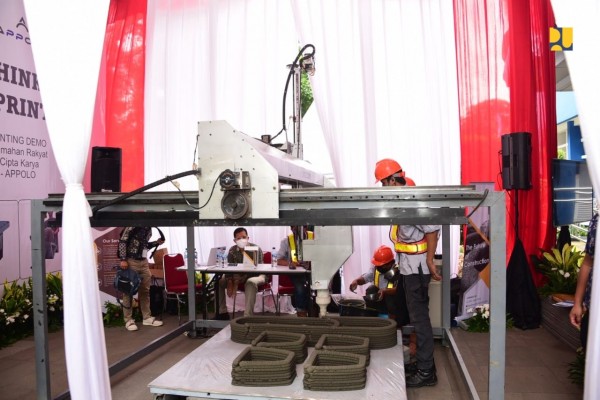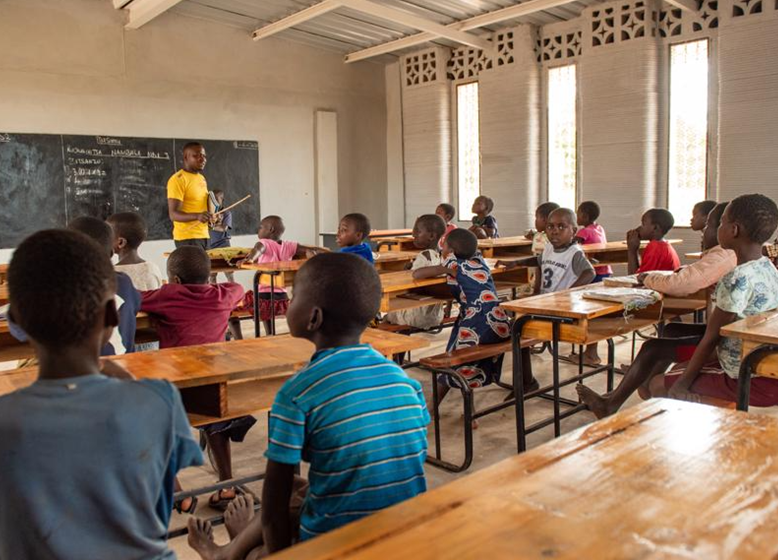Indonesia’s Public Works and Public Housing Ministry (PUPR) has begun trialling concrete 3D printing as a means of meeting the country’s demand for affordable infrastructure.
In tests carried out alongside construction firm PT. PP (Persero) Tbk and start-up Autoconz, the PUPR has used the technology to erect structures layer-by-layer from mortar. According to one of the ministry’s Directors Diana Kusumastuti, adopting 3D printing on a wider scale could enable the country to build homes more quickly and sustainably than before, and in future, it’s even planning to construct schools with it.
“This technology really helps us, so we can build faster, more accurately and with precision,” explains Kusumastuti, Indonesia’s Director General of Human Settlements. “It is hoped that this new technology will continue to be developed for school construction in accordance with the provisions of the prototype of the Ministry of the PUPR.”

Autoconz’s ambiguous approach
Although details about the progress of Indonesia’s concrete 3D printing trial, or the exact nature of the equipment being used remain thin on the ground, the technology is known to have been provided by Autoconz. Founded by a group of young Indonesians, the start-up has set itself the broad goal of using additive manufacturing to “provide society with more efficient construction solutions.”
Again, little is known about how the firm’s technology works, but it’s understood to operate similarly to other infrastructure 3D printing approaches, in that concrete is deposited in layers into pre-programmed designs. If put into practise, the company says that its process enables the rapid construction of ‘Type-36’ homes in just six weeks, half the time it would currently take, while reducing materials used by 15%.
Autoconz also claims that its technology lowers the number of engineers needed to build housing from a minimum of seven to four, and its inherent flexibility has the potential to unlock novel building designs. Already, the start-up has used its approach to create one-off architectural pieces such as benches, but it’s said to be capable of creating Type-36 and Type 45 walls in addition to small homes as well.
To bring its technology to market, the firm currently offers construction services, in which it provides the consultancy, equipment and design expertise needed to help clients realize full 3D printed buildings. However, Autoconz also says that it aims to become Indonesia’s largest construction 3D printing firm by 2025, thus to achieve this, it has now partnered with the PUPR to begin scaling its approach.
Indonesia’s C3DP experiment
Conducted as part of a project named ‘You’re Still Thinking, Right Now I’m Printing,’ the PUPR’s concrete printing trial is believed to have gotten underway on December 3, 2021. The build was initiated with the help of PT. PP (Persero) Tbk during Indonesia’s Building Information Modeling or ‘BIM’ Week, which was designed to help inform the house modelling tech’s roll-out in construction across the country.
Over the last 68 years, PT. PP (Persero) Tbk has become one of Indonesia’s largest construction firms, erecting everything from hotels to government infrastructure like Jayapura State’s finance building, and it was awarded around 2.25 trillion Indonesian rupiahs worth of state-backing (or $157 million) back in 2016.
With the firm’s help, the PUPR says it has now been able to scale the use of Autoconz’s technology through its state-owned BUMN enterprise, in a way that could “change the ecosystem in the construction world… so that it can create affordable housing for all people,” and enable the erection of higher quality buildings in future.
“This 3D printing innovation by the nation’s children is proof of the collaboration between the Ministry of PUPR, BUMN and start-up companies consisting of the younger generation of Indonesia,” added PUPR Minister Basuki Hadimuljono. “[The project also] provides a direction of focus on the development of important sectors that encourage Indonesia’s strength in the eyes of the world.”

3D printing affordable infrastructure
Thanks to its reported material, labor and lead time efficiency benefits, concrete 3D printing continues to find ever-larger and more ambitious infrastructure applications. In fact, if built, Indonesia’s proposed schools won’t even be the first of their kind, as 14Trees deployed a COBOD 3D printer to construct a school inside 18 hours in Malawi earlier this year.
The technology has also been used by the likes of Alquist3D, Printed Farms Florida and the PERI Group to address the USA’s affordable housing crisis. With a mixture of state-backing and the support of non-profit Habitat for Humanity, each firm has built low-cost homes over the last year that showcase 3D printing’s potential in social housing construction.
Similarly, in the past, ICON has deployed its proprietary Vulcan system to build a community of 3D printed houses in Latin America alongside another non-profit New Story. Since then, the firm has gone on to build several more homes across the U.S, and raised $207 million, with which it aims to “bring housing and construction into the modern world.”
To stay up to date with the latest 3D printing news, don’t forget to subscribe to the 3D Printing Industry newsletter or follow us on Twitter or liking our page on Facebook.
For a deeper dive into additive manufacturing, you can now subscribe to our Youtube channel, featuring discussion, debriefs, and shots of 3D printing in-action.
Are you looking for a job in the additive manufacturing industry? Visit 3D Printing Jobs for a selection of roles in the industry.
Featured image shows the PUPR’s concrete 3D printing trial in-action. Photo via the PUPR.



